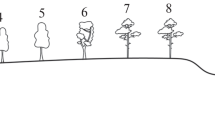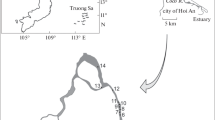Abstract
Testate amoeba (TA) assemblages were collected in 2005 from four ponds in Komořany (Prague, Czech Republic). An analysis of seasonal taxonomic variability of TA populations and its correlation with the limnological characteristics of the area (temperature, pH, total organic carbon, nitrogen, phosphorus, heavy metals, etc.) was performed. The predominant genera were Difflugia, Arcella, and Centropyxis. The most significant changes in the TA community occurred between March and July. Arcella genus dominated in March and April; in May, Arcella and Centropyxis genera were present in the same amount; in June, Arcella genus disappeared, and Difflugia genus started to dominate the community. A multivariate redundancy analysis showed statistically significant correlations between the environmental parameters and the composition of the TA community. The results indicate a negative correlation between TA quantities and Ni, Cd, PAH, Mn, As, and Pb. TA were also affected by concentrations of NH +4 , NO −3 , and P, as well as by temperature variations. The observed correlations between the species composition and environmental parameters can be used in paleoecological interpretations of fossil TA communities. Our results also prove the suitability of TA as water quality indicators in urban areas.










Similar content being viewed by others
References
Asioli A, Medioli FS, Patterson T (1996) Thecamoebians as a tool for reconstruction of paleoenvironments in some Italian lakes in the foothills of the southern Alps (Orta, Varese and Candia). J Foramin Res 26:248–263
Balík V (1991) The effect of the road traffic pollution on the communities of testate amoebae (Rhizopoda, Testacea) in Warsaw (Poland). Acta Protozool 30:5–11
Balík V, Song B (2000) Benthic freshwater testate amoebae assemblages (Protozoa: Rhizopoda) from Lake Dongting, People's Republic of China, with description of a new species from the genus Collaripyxidia. Acta Protozool 39:149–156
Bartoš E (1954) Koreňonožce radu testacea. Vydavatelstvo Slovenskej akadémie vied, Bratislava
Booth RK (2002) Testate amoebae as paleoindicators of surface-moisture changes on Michigan peatlands: modern ecology and hydrological calibration. J Paleolimnol 28:329–348
ter Braak CJF, Šmilauer P (1998) Canoco reference manual and users guide to Canoco for Windows. Microcomputer Power, Ithaca
Burbidge SM, Schröder-Adams CJ (1998) Thecamoebians in Lake Winnipeg: a tool for Holocene paleolimnology. J Paleolimnol 19:309–328
Burdíková Z, Čapek M, Ostašov P, Machač J, Pelc R, Mitchell EAD, Kubínová L (2010) Testate amoebae examined by confocal and two-photon microscopy: implications for taxonomy and ecophysiology. Microsc Microanal 16:735–746
Clarke KJ (2003) Guide to the identification of soil protozoa—testate amoebae. Freshwater Biological Assn, Cumbria
Collins ES, McCarthy FMG, Medioli FS, Scott DB, Hönig CA (1990) Biogeographic distribution of modern thecamoebians in a transect along the eastern north American coast. In: Hembleden C, Kaminski M, Kuhnt W, Scott DB (eds) Paleoecology, biostratigraphy, paleoceanography and taxonomy of agglutinated foraminifera. Kluwer Academic Publishers, Dordrecht, pp 783–792
Charman DJ (1997) Modeling hydrological relationships of testate amoebae (Protozoa: rhizopoda) on New Zealand peatlands. J Roy Soc New Zeal 27:465–483
Charman DJ (2001) Biostratigraphic and palaeoenvironmental applications of testate amoebae. Quaternary Sci Rev 20:1753–1764
Chlupáč I, Brzobohatý R, Kovanda J, Straník Z (2011) Geologická minulost České republiky. Academia, Prague
Dalby AP, Kumar A, Moore JM, Patterson RT (2000) Preliminary survey of arcellaceans (thecamoebians) as limnological indicators in tropical lake Sentani, Irian Jaya, Indonesia. J Foramin Res 30:135–142
Davis SR, Wilkinson DM (2004) The conservation management value of testate amoebae as ‘restoration’ indicators: speculations based on two damaged raised mires in northwest England. Holocene 14:135–143
Ellison RL (1995) Paleolimnological analysis of Ullswater using testate amoebae. J Paleolimnol 13:51–63
Ellison RL, Ogden CG (1987) A guide to the study and identification of fossil testate amoebae in quaternary lake sediments. Int Revue ges Hydrobiol 72:639–652
Escobar J, Brenner M, Whitmore TJ, Kenny WF, Curtis JH (2008) Ecology of testate amoebae (thecamoebians) in subtropical Florida lakes. J Paleolim 40:715–731
Foissner W (1997) Protozoa as bioindicators in agroecosystems, with emphasis on farming practices, biocides, and biodiversity. Agric Ecosyst Environ 62:93–103
Gilbert D, Amblard C, Boudier G, Francez AJ (1998) Short-term effect of nitrogen enrichment on the microbial communities of a peatland. Hydrobiologia 373(374):111–119
Golemansky V (1970) A list of testacea (Protozoa, Rhizopoda) from the Duszatynskie lakes in Poland. Fragment faunistica 16:21–25
Haman D (1982) Modern thecamoebinids (Arcellinida) from the Balize Delta, Louisiana. Trans GCAGS 32:353–376
Heal OW (1964) Observations on the seasonal and spatial distribution of testacea (Protozoa: Rhizopoda) in Sphagnum. J Anim Ecol 33:395–412
Jongman RHG, ter Braak CJF, van Tongeren OFR (1995) Data analysis in community and landscape ecology. Cambridge University Press, Cambridge
Krashevska V, Maraun M, Ruess L, Scheu S (2010) Carbon and nutrient limitation of soil microorganisms and microbial grazers in a tropical montane rain forest. Oikos 119:1020–1028
Kumar A, Dalby AP (1998) Identification key for Holocene lacustrine arcellacean (thecamoebian) taxa. Paleontol Soc 1:1–39. http://www.uic.edu/orgs/paleo/homepage.html. Accessed 10 March 2010
Lorencová M (2009) Thecamoebians from recent lake sediments from the Šumava Mts, Czech Republic. B Geosci 84:359–376
Lamentowicz Ł, Gąbka M, Lamentowicz M (2007) Testate amoebae (Protists) of peatland: species composition and environmental parameters. Pol J Ecol 55:749–759
Medioli FS, Scott DB (1983) Holocene Arcellacea (thecamoebians) from eastern Canada. Cushman Foundation, Washington
Medioli FS, Scott DB (1988) Lacustrine thecamoebians (mainly arcellaceans) as potential tools for palaeolimnological interpretations. Palaeogeogr Palaeoclimatol Palaeoecol 62:361–386
Medioli FS, Scott DB, Collins ES, McCarthy FMG (1990) Fossil thecamoebians: present status and prospects for the future. In: Hemleben C, Kaminski MA, Kuhnt W, Scott DB (eds) Paleoecology, biostratigraphy, paleoceanography and taxonomy of agglutinated Foraminifera, vol 327, NATO Advanced Study Institute Series, Series C, Mathematical and Physical Science. Springer, New York, pp 813–840
Mitchell EAD, Buttler AJ, Warner BG, Gobat JM (1999) Ecology of testate amoebae (Protozoa: Rhizopoda) in Sphagnum peatlands in the Jura Mountains, Switzerland and France. Ecoscience 6:565–576
Mitchell EAD, Gilbert D (2004) Vertical micro-distribution and response to nitrogen deposition of testate amoebae in Sphagnum. J Eukaryot Microbiol 51:480–490
Morcazewski J (1961) Testacea du littoral peu profond du lac Kisajno (Region des lacs de mazurie). Pol Arch Hydrobiol 9:175–194
Nguyen-Viet H, Bernard N, Mitchell EAD, Cortet J, Badot PM, Gilbert D (2007) Relationship between testate amoeba (Protist) communities and atmospheric heavy metals accumulated in Barbula indica (Bryophyta) in Vietnam. Microb Ecol 53:53–65
Nguyen-Viet H, Bernard N, Mitchell EAD, Badot PM, Gilbert D (2008) Effect of lead pollution on testate amoebae communities living in Sphagnum fallax: an experimental study. Ecotox Environ Safe 69:130–138
Ogden CG (1983) Observations on the systematics of the genus Difflugia in Britain (Rhizopoda, Protozoa). Bull Br Mus nat Hist (Zool) 44:1–73
Ogden CG, Hedley RH (1980) An atlas of freshwater testate amoebae. Publication No 814. Oxford University Press, New York
Patterson RT, Barker T, Burbidge SM (1996) Arcellaceans (thecamoebians) as proxies of arsenic and mercury contamination in northeastern Ontario lakes. J Foramin Res 26:172–183
Patterson RT, Kumar A (2000) Assessment of Arcellacean (thecamoebian) assemblages, species, and strains as contaminant indicators in James Lake, northeastern Ontario, Canada. J Foramin Res 30:310–320
Patterson RT, Kumar A (2002) A review of current testate rhizopod (thecamoebian) research in Canada. Palaeogeogr Palaeoclimatol Palaeoecol 180:225–251
Patterson RT, MacKinnon KD, Scott DB, Medioli FS (1985) Arcellaceans (thecamoebians) in small Lakes of New Brunswick and Nova Scotia: modern distribution and Holocene stratigraphic changes. J Foraminifer Res 15:114–137
Payne R, Mitchell E (2007) Ecology of testate amoebae from mires in the Central Rhodope Mountains, Greece and development of a transfer function for paleohydrological reconstruction. Protist 158:159–171
Payne JP (2011) Can testate amoeba-based palaeohydrology be extended to fens? J Quaternary Sci 26:15–27
Qin Y, Booth RKK, Gu Y, Wang Y, Xie S (2009) Testate amoebae as indicators of 20th century environmental change of Lake Zhangdu, China. Fund Appl Limnol 175:29–38
Reinhardt ED, Daldy AP, Kumar A, Patterson RT (1998) Arcellaceans as pollution indicators in mine tailing contaminated lakes near Cobalt, Ontario, Canada. Micropaleontology 44:131–148
Roe HM, Patterson RT (2006) Distribution of thecamoebians (testate amoebae) in small lakes and ponds, Barbados, West Indies. J Foram Res 36:116–134
Roe HM, Patterson RT, Swindles GT (2010) Controls on the contemporary distribution of lake thecamoebians (testate amoebae) within the Greater Toronto Area and their potential as water quality indicators. J Paleolimnol 43:955–975
Sageman BB, Bina CR (1997) Diversity and species abundance patterns in Late Cenomanian black shale biofacies, Western Interior, US. Palaios 12:449–466
Schönborn W (1990) Shell polymorphism and habitat structure in testacea (Rhizopoda). J Protozool 37:62A
Scott DB, Medioli FS (1983) Agglutinated rhizopods in Lake Erie: modern distribution and stratigraphic implication. J Paleontol 57:809–820
Scott DB, Medioli FS, Schafer CT (2001) Monitoring in coastal environments using foraminifera and thecamoebian indicators. Cambridge University Press, Cambridge
Swindles GT, Roe HM (2007) Examining the dissolution characteristics of testate amoebae (Protozoa: Rhizopoda) in low pH conditions: implications for peatland palaeoclimate studies. Palaeogeogr Palaeocl 252:486–496
Štěpánek M, Veselý J, Majer V (1992) The major importance of nitrate increase for the acidification of two lakes in Bohemia. Documenta Dell’Istituto Italiano Di Idrobiologia 32:83–92
Vohník M, Burdíková Z, Albrechtová J, Vosátka M (2009) Testate amoebae (Arcellinida and Euglyphida) vs. Ericoid mycorrhizal and DSE fungi: a possible novel interaction in the mycorrhizosphere of ericaceous plants? Microb Ecol 57:203–214
Vohník M, Burdíkova Z, Vyhnal A, Koukol O (2011) Interactions between testate amoebae and saprotrophic microfungi in a Scots pine litter microcosm. Microb Ecol 61:660–668
Wall AAJ, Magny M, Mitchell EAD, Vanniere B, Gilbert D (2010) Response of testate amoeba assemblages to environmental and climatic changes during the Lateglacial–Holocene transition at Lake Lautrey (Jura Mountains, eastern France). J Quaternary Sci 25:945–956
Warner BG, Asada T, Quinn NP (2007) Seasonal influences on the ecology of testate amoebae (Protozoa) in a small Sphagnum peatland in Southern Ontario, Canada. Microb Ecol 54:91–100
Acknowledgements
This study was supported by the Academy of Sciences of the Czech Republic (grant No. AV0Z50110509 and grant No. AV0Z50200510), Ministry of Education, Youth and Sports of the Czech Republic (research programs LC06063, MSM6840770012, MSM0021620855), and the Czech Science Foundation (P108/11/0794). We also wish to express many thanks to David M. Wilkinson, Radek Pelc, and reviewers for their fruitful comments on earlier version of the manuscript.
Author information
Authors and Affiliations
Corresponding author
Electronic supplementary material
Below is the link to the electronic supplementary material.
ESM 1
(PDF 1207 kb)
Rights and permissions
About this article
Cite this article
Burdíková, Z., Čapek, M., Švindrych, Z. et al. Ecology of Testate Amoebae in the Komořany Ponds in the Vltava Basin. Microb Ecol 64, 117–130 (2012). https://doi.org/10.1007/s00248-011-0003-9
Received:
Accepted:
Published:
Issue Date:
DOI: https://doi.org/10.1007/s00248-011-0003-9




